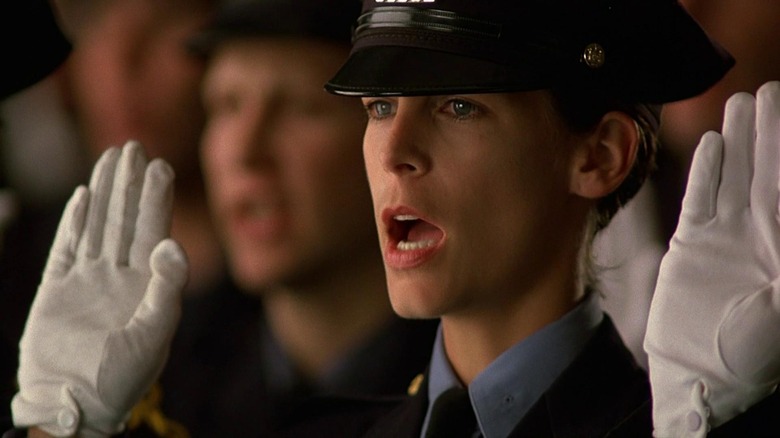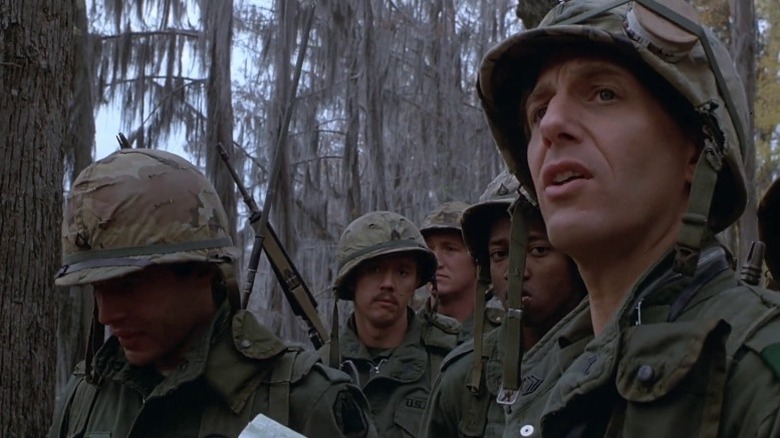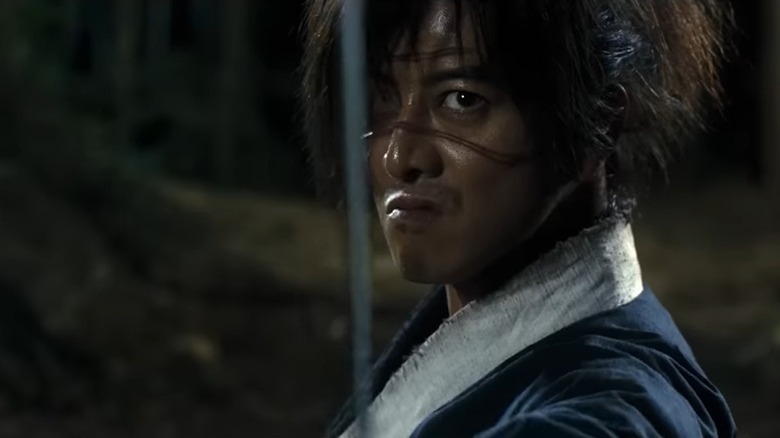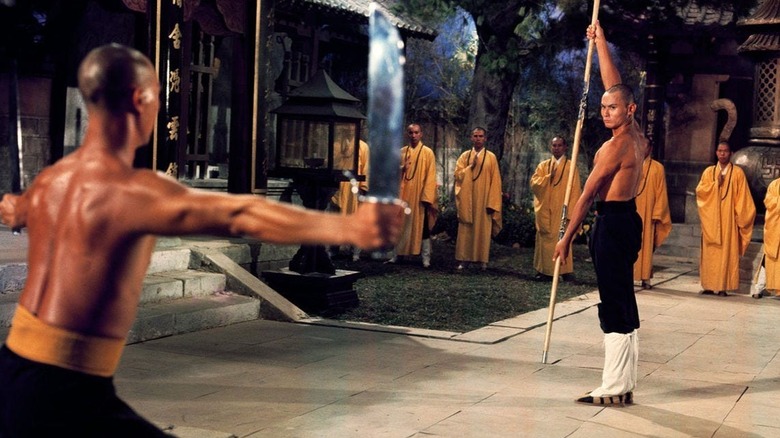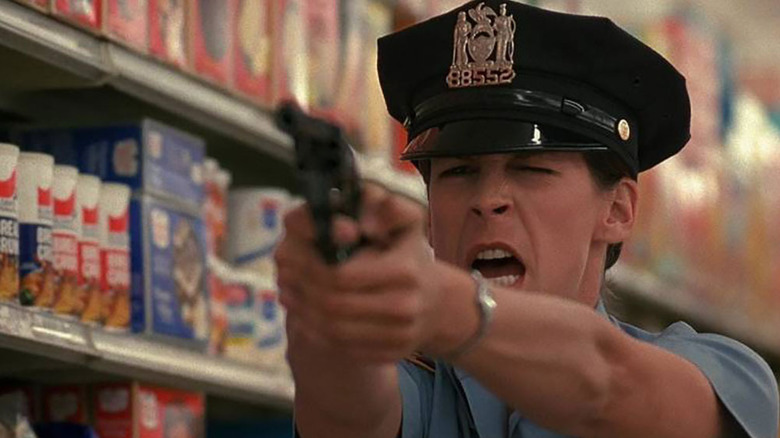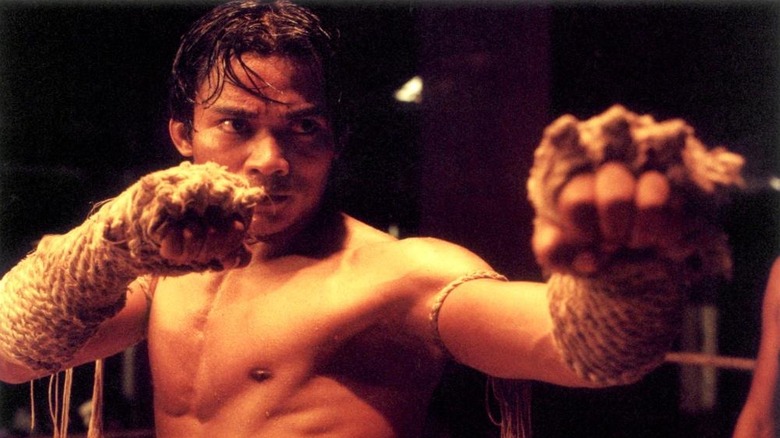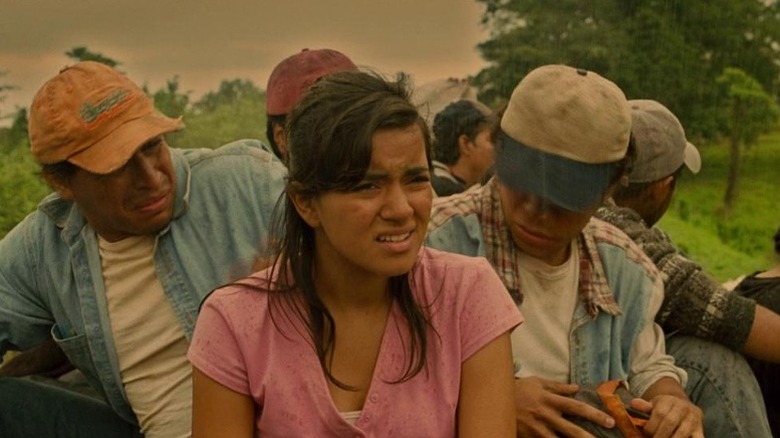Hidden Action Gems You Can Watch On Amazon Prime Right Now
Of all movie genres, action may be the single most inexhaustible: If all else fails, there will still always be a way to keep audiences engaged by training their focus on movement, excitement, danger, and the threat, consummation, or mutual exchange of violence. Thanks to that relatively simple yet potent base requirement, a great action film can take wildly different forms: It can be a loud and thumping carnival of gunshots, a monument of vehicular mayhem, a chanbara film filled to the brim with brutal swordfighting, a tense and taut thriller that saves the violence for key moments, or a carefully choreographed dance spectacle in which each movement is another blow.
Each of those variations can produce good and terrible films alike — and, among the good ones, it's just as possible for them to become massively famous and beloved or fade into relative cultural insignificance, as any action movie buff can attest. In other words, there will always be a wide array of great action films out there waiting to be discovered by any given viewer, and, as it happens, a lot of those films can be found on Amazon Prime Video.
Here, we've compiled a list of hidden gems in the action genre that can be watched at no additional charge if you're a Prime Video subscriber. Some are famous among genre enthusiasts yet generally unsung by the general public, some are all-out obscurities, but each and every one of them is worth watching.
Southern Comfort
One of the most powerful, nerve-racking, and unforgiving action films of the '80s is also among the decade's most unappreciated efforts in the genre. Directed by Walter Hill a few years after his sleeper hit "The Warriors" and a year prior to the smashing success of "48 Hrs." (an R-rated Eddie Murphy movie you may have forgotten), 1981's "Southern Comfort" didn't go down as one of Hill's zeitgeist-catching genre hits, instead becoming a notorious box office bomb.
It figures, because few Hollywood films have been as fearless and direct as "Southern Comfort" in confronting the machismo, jingoism, lack of care for human life, and general moral rot at the heart of the United States' Cold War-era militarism. It's one of the all-time great films about the Vietnam War — even though it doesn't depict the Vietnam War at all.
The relationship is there, though, if only by implication. Instead of U.S. army soldiers in Southeast Asia, Hill focuses on National Guard soldiers carrying out weekend maneuvers in the Louisiana bayous; in their arrogance, they steal boats from a Cajun campsite to get across a swamp, and accidentally initiate a full-blown war between soldiers and locals. Soon enough, the soldiers find themselves trapped, worn out, and overwhelmed by their sheer disconnect from the country they purport to protect. What follows is a brilliant survival-thriller exercise shot through with the trembling masculine hysteria of an empire coming to terms with its own insignificance.
Blade of the Immortal
Takashi Miike has been known for decades as international cinema's most tirelessly prolific auteur, making anywhere from two to eight movies most years, to say nothing of his ample TV work. In 2017, he reached a particularly awe-inspiring career milestone: completing 100 credits as a director. Befitting the momentousness of the occasion, the film in question also turned out to be one of his finest — although, like most of Miike's oeuvre, it still remains largely and unfairly underdiscussed in the West.
Like many of the most iconic Miike films, "Blade of the Immortal" is an actioner, and a samurai actioner at that. The setup, drawn from the eponymous manga series by Hiroaki Samura, is fairly classic for the subgenre: A lonely wandering samurai named Manji (Takuya Kimura) is approached by the young Rin Asano (Hana Sugisaki), who wants him to avenge the death of her father. The twist, as you might have guessed from the title, is that Manji has been cursed with immortality — inconvenient for his existential well-being, but highly convenient, as it turns out, for the purposes of enabling utterly brutal and intense swordfights against hundreds of men at once.
Although somewhat conventional by Miike's standards, the film is exuberantly satisfying and plenty wild in its own right as, essentially, a nonstop string of stunning maximalist action sequences, buoyed by Kimura and Sugisaki's charisma and the concept's nigh-inexhaustible potential. If you've never seen a Miike joint, it's a great place to start — and there'll be plenty more waiting after it.
The 36th Chamber of Shaolin
If you haven't given yourself the pleasure of diving into the Hong Kong martial arts cinema of the '60s and '70s and witnessing the incredible heights to which it pushed mythical storytelling and action choreography, then the best time to start is now. And when you start, there just might be no better introduction than Lau Kar-leung's "The 36th Chamber of Shaolin" — one of the most towering classics of the genre, yet still a largely little-known quantity among non-aficionados.
Starring the great Gordon Liu in the role that made him a national superstar, "The 36th Chamber of Shaolin" fictionalizes the story of notorious 18th-century monk San Te, telling how he sought sanctuary in the Shaolin Monastery and began to train as a kung fu disciple in order to assist in the rebellion against the Qing dynasty's Manchu government. Large portions of the movie consist of training sequences, and they are among the best ever committed to film — triumphs of kineticism that allow the viewer to revel in the step-by-step process and eventual exhilaration of learning the ways of kung fu.
The proper fight sequences that follow the training section are equally exhilarating, aided by the experience Lau had honed for years as a choreographer and underrated martial arts actor in his own right. On top of all that, the 1978 film's story of indomitable resistance in the face of oppression is as irresistible as they come.
Blue Steel
Kathryn Bigelow's filmography is a history of narrative and stylistic transformation within a typical set of thematic interests: justice, power, authority, the psychosexual allure that those things hold, and the obsessions they can engender. Before crossing over to widespread critical prestige and history-making Oscar glory in the back half of her career, Bigelow made her share of films that — although trafficking in genre tropes and therefore less compatible with the "respectable" sheen of "The Hurt Locker" or "Zero Dark Thirty" — still tackled weighty themes with their own kind of auteurist aplomb.
Virtually all of them could be called underrated — even a hit like "Point Break" doesn't always get its due as an all-out masterpiece — but 1990's "Blue Steel" stands out as the true hidden gem of her catalog. In keeping with Bigelow's frequent investigations of American state power, "Blue Steel" is a cop movie. Headlining the cast is Jamie Lee Curtis in one of her best movie roles to date: Megan Turner, a rookie NYPD officer who enters a psychologically draining cat-and-mouse game with a serial killer (Ron Silver).
If you know how Bigelow operates, you already know that what follows is no boilerplate procedural: With a keen eye for the nuances of power and violence involved in being a woman in law enforcement, the film uses its police story framing to search deep into Megan's psyche as she confronts the horrors of her chosen line of work for the first time. It's as thrilling as it is indelible.
Wild Target
Before Emily Blunt starred in some of her biggest movies of all time and cemented herself as a leading movie star, she had a somewhat lengthy career period in which she seemed to always be teetering just on the edge of a massive breakout. That period, roughly extending from her 2004 debut in Paweł Pawlikowski's "My Summer of Love" to her 2015 prestige level-up as the star of Denis Villeneuve's "Sicario," included a large amount of underrated films like "The Young Victoria," "Looper," and "Your Sister's Sister." And then there was "Wild Target," which was underrated even among the underrated — and still doesn't get much space in discussions of Blunt's oeuvre.
It certainly should, though, if only for the extent to which the movie builds itself around Blunt's outsized, mind-boggling charisma. A remake of the eponymous 1993 French film, "Wild Target" stars Bill Nighy as Victor Maynard, a lonely and reclusive yet incredibly efficient contract killer who finds himself in unfamiliar territory when he becomes smitten with his latest target, Rose (Blunt), a brilliant con artist. Resolving to protect her instead of killing her, Victor poses as a private detective and gets himself, Rose, and unlikely protegé Tony (Rupert Grint) into an ungodly mess of violent criminals all attempting to get the better of each other. The ensuing mix of dark comedy and gleeful violence is cheeky yet mannered in that uniquely, hilariously British way — and Blunt reigns over it all with a superstar turn.
Ong-Bak
There are lots of ways for action movies to sell themselves: They can emphasize the scale and production value, the kineticism of the storytelling, the brashness of the tone, or the intensity of the violence. Or, if they've got the chops for it, they can simply put themselves forth as festivals of spectacular fight choreography. That's just what the Thai film "Ong-Bak" did in 2003, reviving the tradition of martial-arts-centric B-movies of the '70s and '80s by holding to the same infallible formula of success: Good fights, good editing, stunts impressive enough to mark it as one of the best parkour action movies, and a fantastic actor-slash-trained fighter at the center.
It's no wonder that the actor in question, Tony Jaa, rose rapidly to become one of the most popular action stars of the 21st century. Nor is it at all surprising that, following its smashing success in Thailand, the film helped popularize Muay Thai around the world. Watching Jaa throw fists and elbows and knees and feet in "Ong-Bak," it's pretty much impossible not to marvel at the combination of power, technique, grace, and subtle acting skill involved. The plot follows a Muay Thai boxer who travels to Bangkok on behalf of his village to retrieve a sacred statue's head after it's stolen by criminals, but really, the story is of little consequence here. What matters is the way Jaa's Ting takes on goon after goon with the kind of balletic skill that turns action movie stars into living legends.
Sin Nombre
Executive produced by Diego Luna and Gael García Bernal, 2009's "Sin Nombre" is a border-crossing adventure thriller that balances action and suspense with enough social conscience and political urgency to make for a great piece of dramatic storytelling apart from the genre elements. The film, written and directed by Cary Joji Fukunaga in a social-realist mode to which he'd return six years later with "Beasts of No Nation," stars Paulina Gaitán as Sayra, a Guatemalan teenage girl traveling to Mexico with her father and uncle, in hopes of later migrating from there to the United States and reaching relatives in New Jersey.
Gaitán gives a revelatory performance in the role, and so does her primary screen partner Edgar Flores, who plays Willy a.k.a. El Casper, a young Mexican gang member who crosses paths with Sayra while fleeing Mexico on the same train as her. The film is infused with all the kinetic energy you'd expect from a caper largely set on a train, the tales of Sayra's journey and Casper's fledgling gang life are equally compelling, and the different genre modes — action, romance, thriller — are woven together seamlessly. But what really makes "Sin Nombre" essential viewing is the way that it wraps the nightmarish, Kafkaesque predicament of Latin American undocumented immigrants into a universally intelligible and heartrending story. Years later, the film remains vital.
